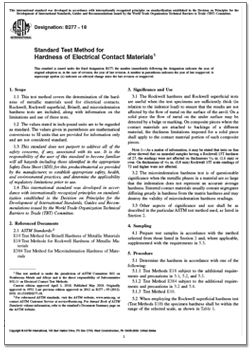英文名称:
ASTM B277-18
Standard Test Method for Hardness of Electrical Contact Materials
中文名称:
ASTM B277-18
电接触材料硬度的标准试验方法
替代情况:替代ASTM B277-95(2012)
代号说明:
This standard is issued under the fixed designation B277; the number immediately following the designation indicates the year of original adoption or, in the case of revision, the year of last revision. A number in parentheses indicates the year of last reapproval. A superscript epsilon (ε) indicates an editorial change since the last revision or reapproval.
版本说明:
1 This test method is under the jurisdiction of ASTM Committee B02 on Nonferrous Metals and Alloys and is the direct responsibility of Subcommittee B02.11 on Electrical Contact Test Methods.
Current edition approved April 1, 2018. Published May 2018. Originally approved in 1952. Last previous edition approved in 2012 as B277 – 95 (2012). DOI: 10.1520/B0277-18.
2 For referenced ASTM standards, visit the ASTM website, www.astm.org, or contact ASTM Customer Service at service@astm.org. For Annual Book of ASTM Standards volume information, refer to the standard’s Document Summary page on the ASTM website.
标准正文:
1. Scope
1.1 This test method covers the determination of the hardness of metallic materials used for electrical contacts. Rockwell, Rockwell superficial, Brinell, and microindentation
hardness tests are included, along with information on the limitations and use of these tests.
1.2 The values stated in inch-pound units are to be regarded as standard. The values given in parentheses are mathematical conversions to SI units that are provided for information only and are not considered standard.
1.3 This standard does not purport to address all of the safety concerns, if any, associated with its use. It is the responsibility of the user of this standard to become familiar will all hazards including those identified in the appropriate Safety Data Sheet (SDS) for this product/material as provided by the manufacturer, to establish appropriate safety, health, and environmental practices, and determine the applicability of regulatory limitations prior to use.
1.4 This international standard was developed in accordance with internationally recognized principles on standardization established in the Decision on Principles for the
Development of International Standards, Guides and Recommendations issued by the World Trade Organization Technical Barriers to Trade (TBT) Committee.
2. Referenced Documents
2.1 ASTM Standards:
E10 Test Method for Brinell Hardness of Metallic Materials
E18 Test Methods for Rockwell Hardness of Metallic Materials
E384 Test Method for Microindentation Hardness of Materials
3. Significance and Use
3.1 The Rockwell hardness and Rockwell superficial tests are useful when the test specimens are sufficiently thick (in relation to the indentor load) to ensure that the results are not affected by the flow of metal on the surface of the anvil. On a solid piece the flow of metal on the under surface may be detected by a bulge or marking. On composite pieces where the contact materials are attached to backings of a different material, the thickness limitations imposed for a solid piece shall apply to the contact material portion of such composite pieces.
NOTE 1—As a matter of information, it may be stated that tests on fine silver showed that on annealed samples having a Rockwell 15T hardness of 27, the readings were not affected on thicknesses 1 ⁄ 16 in. (1.6 mm) or over. On thicknesses of 1 ⁄ 32 in. (0.8 mm) Rockwell 15T scale readings of 72 and higher were not affected.
3.2 The microindentation hardness test is of questionable significance when the metallic phases in a material are so large that the indentation does not represent an accurate average hardness. Sintered contact materials usually contain segregates differing greatly in hardness from the matrix hardness and may destroy the validity of microindentation hardness readings.
3.3 Other aspects of significance and use shall be as described in the particular ASTM test method used, as listed in Section 2.
在线阅读 免费下载







